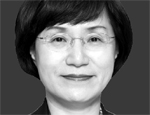Worst of yen weakening still ahead

Kwon Seon-joo
But regardless of the yen’s decisive weakening, Korean exports remained robust, helping to bring in a trade surplus for the 25th consecutive month since February 2012. Exports last year rose by 2.1 percent and the trade surplus was a record-high $44 billion.
Japan, in contrast, recorded its largest-ever trade deficit of 11 trillion yen ($105.9 billion). The data spurred a flurry of skepticism in regard to Abenomics, the aggressive fiscal and monetary easing launched by the Abe government to depreciate the currency and increase liquidity to buttress exports and industrial activity. Korean companies, on the other hand, gained confidence after overcoming their fear about competing against Japanese exporters armed with a weak currency.
But the real battle may be just starting. It is still early to say the yen’s weakening has been factored into the export equation. Japanese companies have not actually reflected the weakness of the yen in their market prices. Despite the sharp devaluation of the yen over the past year, the cost of Japanese exports has not gone down much, dropping only 1.7 percent year-on-year in December in settlement currency and 9.1 percent in U.S. dollars. Instead of boosting shipments by bringing down prices, Japanese companies chose to improve earnings through foreign exchange gains.
That translated into a sharp turnaround in profit numbers for Japanese exporters. Once overall operations improve, they will increase investment and advance technology and competitiveness. Japanese manufacturers have survived decades of a strong yen through innovations in production processes, technology development and management restructuring. Korean companies now would have to face stronger, leaner and financially apt Japanese competitors in overseas markets.
Many experts predict the yen’s weakening will continue for at least one or two years. The Japanese central bank has been carrying out quantitative easing for a year now on an unprecedented scale - purchasing bonds worth 60 trillion yen ($580 billion) to 70 trillion yen a year - to nearly double the monetary base by the end of 2014. It is expected to scale up its bond-purchase program to help boost liquidity and spending this month when the sales tax will go from 5 percent to 8 percent. The liquidity rush will weigh on the yen, and the devaluation of the currency will continue.
Korean companies, therefore, have not yet begun to see the worst of the weaker yen. Exports are up more than 50 percent of Korea’s output. If exports turn sluggish, the domestic economy cannot be revived. Smaller companies that still lag behind in brand power and quality won’t be able to compete against lower-priced Japanese products.
It is good the government and Korean companies have grown more confident about exports and competitiveness. But they should be warned against optimism. They must look ahead and prepare. Companies must invest aggressively in research and development and try to come up with structural and fundamental solutions to strengthen competitiveness.
If the yen’s weakening lasts, short-term makeshift actions won’t work. Some large companies will be tempted to shift their losses to subcontractors. The government will have to strengthen supervision of antitrust and unfair business practices to minimize damage to small and midsize manufacturers.
Translation by the Korea JoongAng Daily staff.
JoongAng Ilbo, April 1, Page B11
*The author is the president of the Industrial Bank of Korea.
BY Kwon Seon-joo










with the Korea JoongAng Daily
To write comments, please log in to one of the accounts.
Standards Board Policy (0/250자)